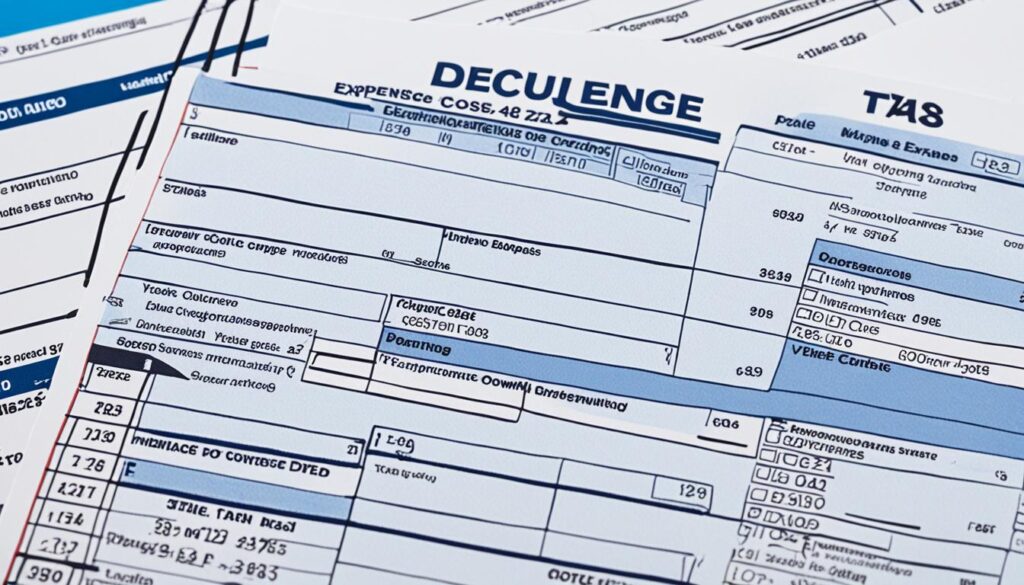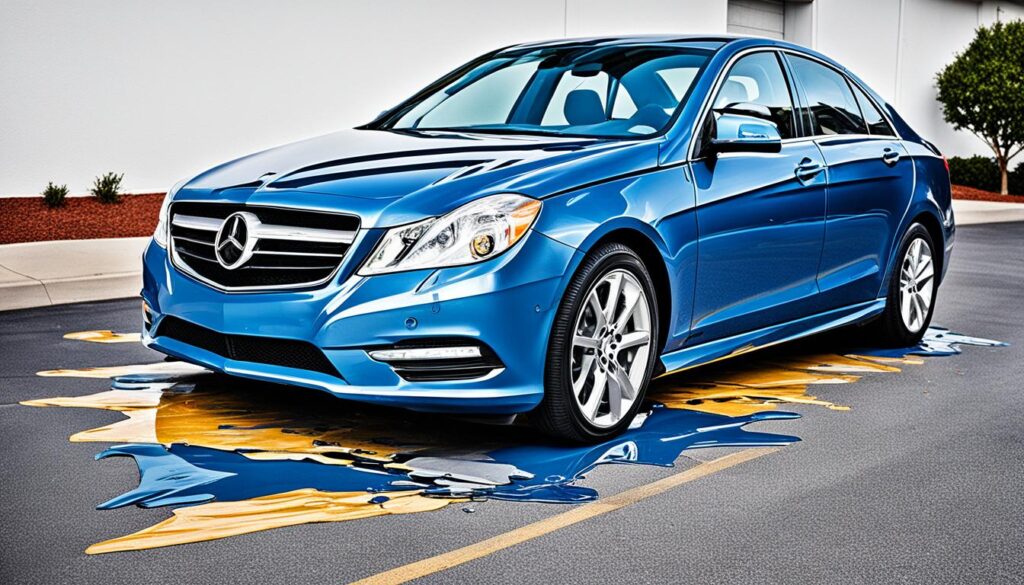Did you know that you may be able to deduct the costs of your vehicle for business? This includes cars, SUVs, or pickup trucks used for business. There are tax deductions that can lower your expenses. But what are the rules by the IRS?
We will look at how to deduct vehicle expenses, including the standard mileage rate and actual expense method. You’ll learn about the rules and limitations for claiming vehicle expenses on your taxes. We will also talk about depreciation and recordkeeping, and how to report deductions on your tax return.
Learn how to use these deductions to reduce your business expenses and increase your tax benefits. Let’s explore how to deduct vehicle expenses for business!

Key Takeaways:
- There are two methods for deducting vehicle expenses: the standard mileage rate method and the actual expense method.
- The standard mileage rate method allows you to deduct a certain amount per mile driven for business.
- The actual expense method requires you to track and deduct the actual costs of gas, repairs, insurance, and more.
- It’s important to keep thorough records of your vehicle expenses to support your deductions.
- Report your car expenses accurately and in the appropriate section of your tax return to maximize your deductions.
Standard Mileage Rate Method
Many people and small business owners choose the standard mileage rate method to deduct car expenses for business. It lets you deduct a set amount for each mile driven for business, which can lower your taxes.
The IRS sets the standard mileage rate yearly. For 2023, it’s 65.5 cents per mile. So, you can take off 65.5 cents from your taxable income for every business mile.
To use the standard mileage rate, you must meet some requirements. You need to own or lease the car used for business. You should not use more than four cars at once and avoid other depreciation deductions. With a leased car, you can’t claim actual expenses, just the standard mileage rate.
Choosing the standard mileage rate for a car means sticking with it or shifting to actual expenses later. Think about your situation and talk to a tax expert to pick the right method.
The Benefits of the Standard Mileage Rate Method
- Simplicity: It’s generally easier to work out and track the standard mileage than actual expenses. Just note down the business miles.
- Time-saving: This method saves you the hassle of logging every expense like gas and repairs.
- Flexible: It covers various business travels like meetings and client visits.
The standard mileage rate method offers a simple way to claim car expense deductions for your business. Yet, it’s wise to look at how many miles you drive for business and your car’s total running costs.
| Benefits of Standard Mileage Rate Method | Benefits of Actual Expense Method |
|---|---|
| Simple and easy to calculate | Allows you to deduct actual expenses incurred for business use |
| No need to track individual expenses | Provides more accurate deduction based on actual costs |
| Time-saving | Offers flexibility in deducting specific expenses |
Actual Expense Method
The actual expense method lets you write off the real costs of using your car for work. This includes gas, repairs, insurance, registration fees, and the depreciation or lease payments for your business.
When using this method, keeping good records is key. You’ll need to show proof of your expenses. Keep your receipts for gas, oil, repairs, and your insurance and registration fees.
“The actual expense method allows for a more comprehensive deduction of your car’s expenses, making it a beneficial choice if you have high operating costs for your vehicle.”
The actual expense method does need more recordkeeping than the standard mileage method. But, it can give a bigger deduction if your vehicle costs are high.
Note that you can also deduct business-related depreciation or lease payments. Depreciation is when your car loses value over time. Lease payments are what you pay to lease a car.
Using the actual expense method means you can write off all the costs from using your car for work. With accurate records, you can get the most out of your tax savings.
Actual Expense Method: Summary of Deductible Car Expenses
| Expense Category | Examples |
|---|---|
| Gas Expenses | Gasoline, diesel fuel |
| Repair Expenses | Mechanical repairs, bodywork |
| Insurance Expenses | Liability insurance, collision coverage |
| Registration Fees | Vehicle registration, license plate fees |
| Depreciation | Vehicle value decrease over time |
| Lease Payments | Monthly lease payments |

Depreciation
Depreciation is key when it comes to deducting business vehicle expenses. It lets you spread the car’s cost over its lifespan. Understanding the different methods for depreciating vehicles and IRS rules is essential.
The Modified Accelerated Cost Recovery System (MACRS) is used for cars after 1986. MACRS helps in calculating depreciation deductions. It uses set periods for various vehicle categories.
Switching from the standard mileage rate to the actual expense method requires care. If this switch happens before the car is fully depreciated, use straight-line depreciation. This method divides the deduction evenly over the car’s remaining life.
The IRS has set limits on yearly depreciation deductions. These limits are based on vehicle depreciation caps and can change. Keeping up with these updates ensures correct deductions.
Leased cars follow special depreciation rules. The IRS has guidelines for calculating depreciation on these vehicles. Understanding and following these rules is a must for accurate claims on leased cars.

Grasping the nuances of car depreciation and IRS guidelines is vital for business vehicle deductions. By being informed and compliant, you maximize your tax benefits.
Recordkeeping
Keeping accurate records of your car expenses for business is vital. This is because the IRS requires strong proof of your vehicle expenses. These records also protect you if you’re audited.
What records should you maintain? Here are a few examples:
- Gas receipts: Save all your receipts for fuel purchases related to business use.
- Repair invoices: Keep records of any repairs and maintenance performed on your vehicle.
- Insurance statements: Retain your insurance statements to demonstrate the costs of insuring your car.
- Mileage logs: Maintain a detailed mileage log to track your business-related trips and calculate your deductible mileage.
By keeping these records, you make sure your expenses are well documented. Accuracy and detail are crucial here!
For detailed advice on car expense recordkeeping, check Topic no. 305 on the IRS website.

| Records to Keep | Importance |
|---|---|
| Gas receipts | Provide evidence of fuel costs |
| Repair invoices | Show expenses for maintenance and repairs |
| Insurance statements | Substantiate insurance costs |
| Mileage logs | Track and calculate deductible mileage |
Where to Deduct
It’s key to accurately list your car expenses on your tax return. Doing so helps you maximize deductions and follow IRS rules.
If you work for yourself, use Schedule C (Profit or Loss From Business) for car expenses. This form is for sole proprietors or single-member LLCs. It lets you deduct vehicle costs related to your business.
Farmers should use Schedule F (Profit or Loss From Farming) for vehicle expenses. This form is for farming income and expenses. It allows farmers to deduct costs for business-related vehicle use.
Always check IRS guidelines and talk to a tax pro to know the right forms for your car expenses.
Armed Forces reservists, qualified performing artists, or fee-basis officials should fill out Form 2106 (Employee Business Expenses). It’s for employees to deduct car expenses, not for those self-employed.
Car expense deductions differ by profession, so review IRS guidelines and seek expert advice for correct reporting.
Here’s how it works:
Meet John, a self-employed photographer. He travels for work in his car to meetings and photoshoots. John tracks his car costs like gas and repairs. He uses Schedule C to deduct these on his taxes, lowering his taxable income.

Reporting your car expenses correctly can help you get the most out of deductions. Always keep detailed records and get advice from a tax expert.
Key Takeaways for Business Owners
Understanding the key points about deductible vehicles and business vehicle expenses is vital. It helps you maximize your tax deductions. Here’s what you need to know:
- Deductible Vehicles: You can usually deduct the costs of vehicles used for business. This includes cars, SUVs, pickup trucks, and other work-related vehicles.
- Standard Mileage Rate: This method lets you deduct a set amount per mile driven for business. For 2023, the rate is 65.5 cents per mile.
- Actual Expense Method: This method allows for deducting actual vehicle operation costs. This includes expenses like gas, repairs, and insurance.
- Luxury Car Depreciation Limits: There are special limits for luxury cars to avoid large deductions. Knowing these limits is crucial for your deductions.
- Considerations for Choosing a Method: Choose between methods by considering various factors. Think about the vehicle type, costs, ownership, and whether to buy or lease.
Make Informed Decisions to Maximize Tax Deductions
By choosing wisely about deductible vehicles, you can boost your tax deductions and lower your vehicle expenses. Always consult a tax expert to ensure your deductions comply with IRS rules.

Standard Mileage Rate vs. Actual Expenses
Business vehicle expenses can be deducted in two ways: using the standard mileage rate or the actual expense method. Each approach has its own advantages. The best choice depends on your vehicle and business needs.
The Benefits of the Standard Mileage Rate Method
The standard mileage rate method lets you deduct a set amount for every mile driven for business. It’s great for those with cost-effective vehicles. You don’t have to keep track of every gas receipt or repair bill.
This method simplifies things. It’s a good pick if your vehicle doesn’t cost much to operate.
The Benefits of the Actual Expense Method
With the actual expense method, you deduct your vehicle’s real operating costs. This is better for expensive vehicles, like luxury cars. It’s useful if your car needs lots of repairs or guzzles gas. But, you must keep careful records of all expenses.
“Choosing between the standard mileage and actual expenses methods should be based on your vehicle’s costs,” suggests tax professional Sarah Johnson. “Think about gas, repairs, and insurance costs to see which method saves you more on taxes.”
It’s crucial to look at each method’s costs and see which fits your business best. Talking to a tax pro or using tax software is wise. Remember, there are IRS rules for deducting vehicle expenses. Always make sure you’re following them.

| Standard Mileage Rate Method | Actual Expense Method |
|---|---|
| Simple and convenient | Allows deduction of actual costs |
| Beneficial for economical vehicles | Ideal for vehicles with higher operating costs |
| No need for detailed expense tracking | Requires diligent recordkeeping |
| One-size-fits-all deduction rate | Allows for individual expense customization |
Ownership Considerations for Vehicle Expenses
Claiming vehicle expenses on your taxes involves knowing about ownership. For those self-employed, deductions depend on if the vehicle is business or personally owned. If you’re self-employed and own the vehicle, you can choose between the standard mileage or actual expense methods for deductions.
For employees who use their own vehicle for work, there’s a different approach. They can seek reimbursement from their employer using the standard mileage rate. This way, they get compensated for business use of their vehicle.
When a corporation owns the vehicle, things change yet again. Corporations can deduct all vehicle operating expenses, no matter how much the vehicle is used for business. This offers big tax advantages for companies with business-use vehicles.
It’s important to understand the ins and outs of vehicle expense deductions. By knowing the best deduction method and reimbursement options, you can save on taxes. This makes sure you’re making the most of tax savings while following IRS rules.